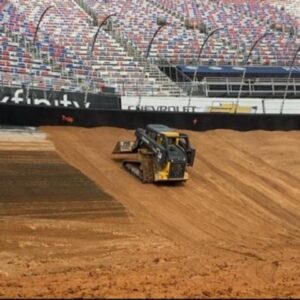NASCAR Cup Series returns to the dirt

On March 28, 2021, the NASCAR Cup Series will race in Bristol, Tennessee, dubbed “The Last Great Coliseum,” for its tall, stadium-style seating arrangements.
The concrete half- mile, high-banked track has been the sight of some of American auto racing’s most exciting moments, and this year’s spring event will be no exception. Twenty years ago, in 2001, the speedway was covered in red clay for a series of “World of Outlaws” late model and sprint car events, and now the dirt has gone down again, for a full slate of dirt races through March and April, this time including the NASCAR Cup Series.
The “Food City Dirt Race” will be the first NASCAR Cup race on dirt since 1970 when the series visited the North Carolina State Fairgrounds. The race was won by NASCAR’s all-time win leader, and “King,” Richard Petty.
NASCAR made a return to dirt in 2013 with its “Camping World Truck Series,” the NASCAR equivalent of “AA” minor league baseball. The trucks had seven races at Eldora Speedway in Rossburg, Ohio from 2013 to 2019, and the crowd was at capacity. Many NASCSAR fans yearn for dirt racing to re-enter the sport on a consistent level, as they entertain themselves at local speedways, many of which are clad in clay.
Early favorites for the 250-lap cup race are Christopher Bell and Kyle Larson, who both have already logged wins on the 2021 cup series season. Other hopefuls include Darrell “Bubba” Wallace Jr, and Austin Dillon, each of whom have dirt experience and each of whom have won a truck series race at Eldora.
Cup series newcomer Chris Windom, the 30-year-old dirt racing champion from Illinois, will be exciting to watch in his NOS Energy sponsored #15 car for Rick Ware Racing. Windom has been a United States Auto Club champion in midgets, sprint cars, and silver crown cars. More dirt specialists are expected to be added to the entry list in the coming weeks.
A large part of NASCAR’s lack of dirt track races has been safety concerns. NASCAR series tracks all have S.A.F.E.R. (Steel and Foam Energy Reduction) barriers instead of concrete walls. The barriers are designed to absorb energy better than concrete walls during crashes and keep drivers safe. Dirt tracks are smaller than most NASCAR series tracks, not usually larger than one mile in length, with many being half- miles, compared to some 1.5, 2, 2.5, and 2.6-mile tracks the series races on during the season. The smaller tracks produce less speed and risk, not necessitating the S.A.F.E.R. barriers as much as larger, faster tracks.
The “Food City Dirt Race” will air live on March 28 at 3:30 PM on Fox. This motorsports spectacle is a can’t miss for any auto racing fan and is hopefully a precursor to more frequent dirt races to come for America’s premier stock car racing series.







